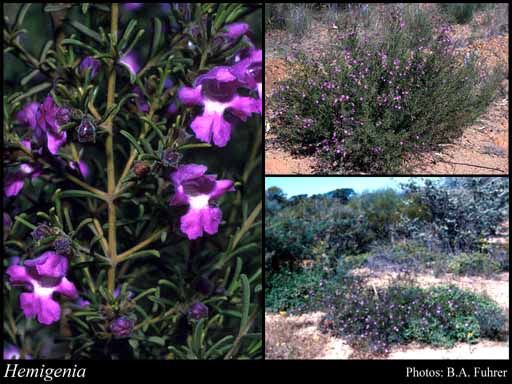- Reference
- Prodr. 502 (1810)
- Name Status
- Current







Scientific Description
Common name. Hemigenias. Family Lamiaceae.
Habit and leaf form. Shrubs; bearing essential oils. Plants spiny, or unarmed. Leaves cauline. Plants with neither basal nor terminal concentrations of leaves. Young stems usually tetragonal. To 0.15–1.4 m high. Leptocaul. Leaves small to medium-sized; opposite, or whorled; decussate; 3 per whorl; not decurrent on the stems; not imbricate; sessile, or petiolate; aromatic, or foetid, or without marked odour; simple; epulvinate. Leaf blades entire; flat, or folded (lengthwise); linear, or oblong, or obovate, or elliptic (to narrowly); one-veined, or pinnately veined; cross-venulate; cordate to cuneate at the base, or rounded at the base. Leaves without stipules. Leaf blade margins entire; flat. Leaves without a persistent basal meristem. Leaf anatomy. Hairs present; glandular hairs present; complex hairs present, or absent. Complex hairs when present, stellate. Urticating hairs absent. Stem anatomy. Secondary thickening developing from a conventional cambial ring.
Reproductive type, pollination. Fertile flowers hermaphrodite. Unisexual flowers absent. Plants hermaphrodite. Entomophilous, or ornithophilous; usually via hymenoptera, or via lepidoptera, or via diptera.
Inflorescence and flower features. Flowers solitary, or aggregated in ‘inflorescences’; axillary. Inflorescence few-flowered. Flowers when clustered, in verticils. The terminal inflorescence unit cymose. Inflorescences axillary; flowers axillary, solitary, rarely clustered. Flowers sessile, or pedicellate; 2- bracteolate. Bracteoles not adnate to the receptacle. Flowers small; very irregular; zygomorphic; cyclic; tetracyclic. Floral receptacle developing a gynophore, or with neither androphore nor gynophore. Free hypanthium absent. Perianth with distinct calyx and corolla; 4–10; 2 -whorled; isomerous, or anisomerous. Calyx present; 5; 1 -whorled; gamosepalous; 5- blunt-lobed to toothed; imbricate, or open in bud; campanulate, or funnel-shaped, or tubular; regular, or bilabiate; non-fleshy; persistent; with the median member posterior. Calyx lobes narrowly triangular (to broadly). Corolla present; disguisedly 5; 1 -whorled; gamopetalous; blunt-lobed; imbricate; bilabiate (the upper lip erect, concave, emarginate or 2-lobed, the lower lip longer, spreading, and 3-lobed with its middle lobe larger and itself emarginate or 2-lobed); hairy abaxially, or glabrous abaxially; plain, or with contrasting markings; blue, or purple, or violet (pale), or white (rarely). Corolla members entire (undulate or crenate). Androecium present. Fertile stamens present. Androecial members definite in number. Androecium 4. Androecial members adnate; markedly unequal; free of one another; 1 -whorled. Androecium exclusively of fertile stamens. Stamens 4; becoming exserted; didynamous, or not didynamous, not tetradynamous; all more or less similar in shape; reduced in number relative to the adjacent perianth; fertile stamens representing the posterior-lateral pair and the anterior-lateral pair; oppositisepalous; all alternating with the corolla members. Filaments filiform. Anthers connivent, or separate from one another; dorsifixed; versatile, or non-versatile; dehiscing via longitudinal slits; introrse; unilocular; tetrasporangiate; appendaged (the obsolete cell represented by an elongated connective with a sterile appendage). Pollen shed as single grains. Fertile gynoecium present. Gynoecium 2 carpelled (the carpels deeply lobed to mimic G4). The pistil 4 celled. Carpels reduced in number relative to the perianth. Gynoecium syncarpous; synstylovarious to eu-syncarpous; superior. Ovary plurilocular; 2 locular (originally), or 4 locular (by intrusions of the ovary wall constituting ‘false septa’). Locules secondarily divided by ‘false septa’. Gynoecium median; stylate. Styles 1; simple; from a depression at the top of the ovary; apical; much longer than the ovary at anthesis; becoming exserted. Stigmas 2; 2 - lobed. Placentation basal. Ovules 2 per locule, or 1 per locule (two per original loculus, but one per locellus); ascending; apotropous; non-arillate; anatropous, or hemianatropous.
Fruit and seed features. Fruit non-fleshy, or fleshy; a schizocarp. Mericarps (2–)4; comprising nutlets. Seeds endospermic to non-endospermic. Embryo well differentiated. Cotyledons 2. Embryo straight.
Special features. The flowering nodes separated by extended internodes. 1–10 flowers subtended by each floral leaf (?—solitary or clustered). Calyx limb 5 lobed. Upper lip of calyx when bilabiate, entire, or lobed; when segmented, 3 lobed. Lower lip of calyx entire, or lobed; when segmented, 2 lobed. Corolla tube exceeding the calyx; straight, or curved. The upper lip of the corolla incorporating 2 members, the lower 3; (posterior, adaxial) lip of the corolla entire (emarginate), or bilobed; upper (adaxial) lip of the corolla markedly concave. Lower (abaxial) lip of the corolla 3 lobed (the middle one itself emarginate or bilobed); not concave. Stamens ascending. The appendages of the fertile anthers attenuate (dilated, bearded or glabrous).
Geography, cytology, number of species. Native of Australia. Endemic to Australia. Australian states and territories: Western Australia, Queensland, and New South Wales. A genus of ca 40 species; 34 species in Western Australia.
Etymology. From the Greek for "half" and either "the part of the face covered by the beard"; the connective is bearded in the upper anthers only; or "birth, offspring"; only one of each pair of anther cells is fertile.
Taxonomic Literature
- Wheeler, Judy; Marchant, Neville; Lewington, Margaret; Graham, Lorraine 2002. Flora of the south west, Bunbury, Augusta, Denmark. Volume 2, dicotyledons. Australian Biological Resources Study.. Canberra..
- Marchant, N. G.; Wheeler, J. R.; Rye, B. L.; Bennett, E. M.; Lander, N. S.; Macfarlane, T. D.; Western Australian Herbarium 1987. Flora of the Perth region. Part one. Western Australian Herbarium.. [Perth]..
- Conn, B. J. 1986. New species of Hemigenia and Microcorys (Labiatae).
- Blackall, William E.; Grieve, Brian J. 1981. How to know Western Australian wildflowers : a key to the flora of the extratropical regions of Western Australia. Part IIIB, (Epacridaceae-Lamiaceae). University of W.A. Press.. [Perth]..